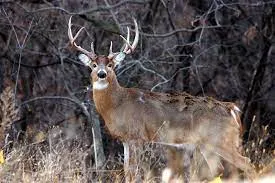As hunters and wildlife enthusiasts, understanding how deer perceive the world around them is crucial. Questions about their ability to see humans, detect colors, and respond to camouflage are common. In this blog, we'll delve into the fascinating world of deer vision, addressing common misconceptions and shedding light on why camouflage is still important, even though deer are color blind.
Deer Vision Basics
1. **Color Blindness**: Contrary to human vision, deer are dichromatic, meaning they primarily see the world in shades of blue and green. They struggle to differentiate between reds and oranges, seeing them as shades of gray.
2. **Low-Light Adaptation**: Deer have excellent night vision, thanks to a high number of rod cells in their retinas. This helps them navigate and feed in low-light conditions.
3. **Peripheral Vision**: Deer possess a wide field of view, nearly 310 degrees. However, their binocular vision is limited, making them adept at detecting movement rather than fine details.
Camouflage and Visibility
1. **In a Stand**: While deer might not see the same level of detail as humans, they are excellent at detecting motion. Staying still in a stand is crucial to avoid alerting them.
2. **Camouflage**: Camouflage patterns break up the human silhouette and reduce the likelihood of catching a deer's attention. Although deer might not see colors as we do, they can still spot solid, contrasting shapes.
3. **High-Contrast Colors**: Colors like white and blue stand out to deer, which perceive them as brighter shades in their monochromatic world.
Deer-Repellent Colors
1. **Bright Colors**: Deer might be more likely to notice and avoid bright, contrasting colors that stand out against the natural environment.
2. **Orange**: While humans often wear orange for safety during hunting season, deer might perceive it as an unusual shade of gray, minimizing its effectiveness as camouflage.
The Role of Camouflage
1. **Breaking Silhouette**: Camouflage helps hunters blend into the surroundings by breaking up the human silhouette. Even though deer don't see colors as humans do, they can still spot solid shapes.
2. **Reducing Motion Detection**: Camouflage aids in reducing the visibility of small movements, which can be the key to staying undetected by the keen senses of deer.
3. **Overall Camouflage Effect**: While deer might not perceive the colors in camouflage patterns, the combination of shading, patterns, and shapes helps hunters merge with the environment.
Conclusion
Understanding deer vision provides valuable insights for hunters and wildlife enthusiasts. While deer's color blindness impacts their perception of certain colors, they remain remarkably skilled at detecting movement and identifying shapes. Camouflage remains an essential tool for blending into the surroundings and reducing the likelihood of spooking deer. So, even if deer don't see colors the way we do, the strategic use of camouflage remains a valuable asset in the pursuit of an effective and respectful interaction with these majestic creatures.

